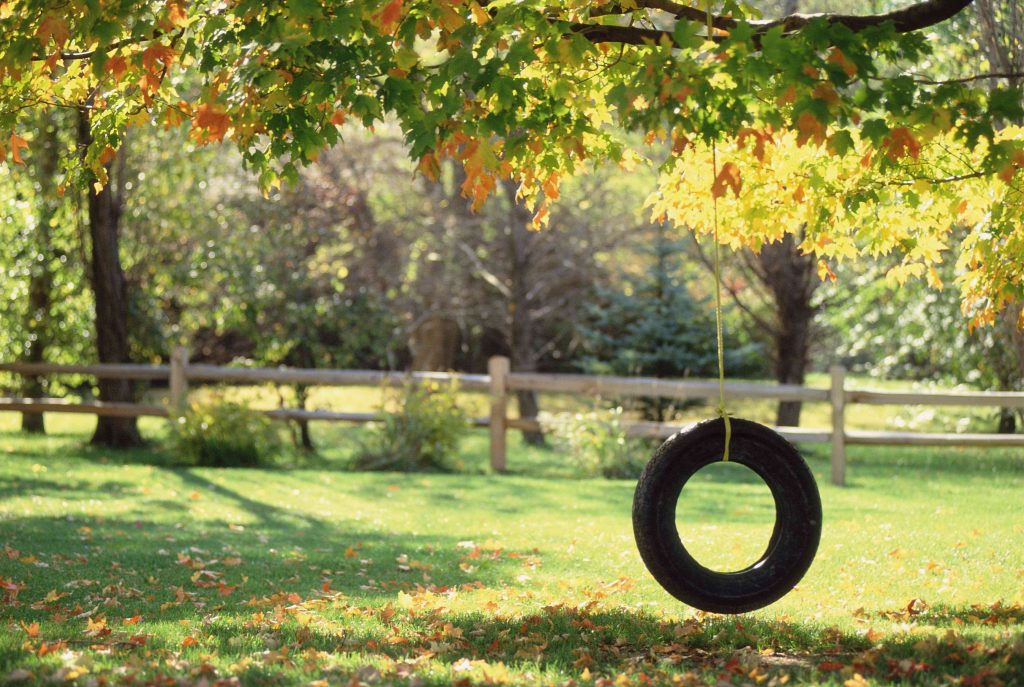Introducing a tire swing to your backyard is sure to be a decision that you (and, more importantly, your kids) will be happy you made. If you’ve seen tire swings and assumed they’re too hard to install or difficult to make safe, you may be surprised to know that this project is actually very simple. And, when done right, tire swings can be a safe form of entertainment for both children and adults.
Safety Considerations
Safely position a step, platform, or extension ladder against the tree for stability. If you plan to use any type of ladder to install the rope of the tire swing over a branch, have someone spot you while you are on the ladder because the ground will likely be uneven. If you do not choose to use a ladder to secure the rope over a branch, a ladder-free method is explained below.
What You’ll Need
Equipment / Tools
- Utility knife
- Measuring tape
- Mason line string
- Bean bag or similar object
- Lighter
- Drill
- 7/8-inch paddle bit
Materials
- Recycled tire
- 50-feet polypropylene rope
Instructions
How to Make a Tire Swing
There are two popular styles of tire swings. One type features a horizontal tire with ropes attached at three equidistant points. The second type features a vertical tire with a rope simply tied around the top of the tire. For this project, we’ll focus on the latter option as it’s quick, easy on the wallet, and a more versatile option for users of all sizes.
-
Find a Strong Branch
A tire swing requires a solid branch at least 8 to 10 inches in diameter and is in good health. The branch should be about 10 to 20 feet from the ground.
Fruit trees, evergreens, and other softwood varieties should be avoided, as these are prone to breaking under pressure. Instead, look for strong, mature trees such as oak trees, maple trees, hickory trees, and other hardwood varieties.
-
Find a Tire
If you don’t have one already, recycled tires in good condition are readily available. Check tire stores, online listings, and family and friends. Look for a relatively large tire with a wide sidewall. If you’re seeking a used tire, opt for one with no dry rot and some tread still intact to ensure it’s durable to sit on.
-
Buy the Rope
Polypropylene rope is perfect for a tire swing, as it won’t be compromised as a result of outdoor exposure. When used properly, 3/4-inch polypropylene rope is more than strong enough to hold the weight of a tire and any potential user. The amount needed will be determined by how far your branch is from the ground. For example, a 50-foot rope should do the trick for a branch that is about 10 to 20 feet above the ground.
What Is Polypropylene Rope?
Polypropylene rope is a strong, synthetic rope that is resistant to rot and deterioration due to water. While many styles are colorful, varieties that imitate the look of natural rope can also be found.
-
Place the Rope Over the Branch
If you don’t have a ladder long enough to lean on the tree branch, there’s an easy way to get your rope over the branch. Simply tie string (something like mason line string will do the trick) around a small object like a bean bag and toss it up over your branch. Once over, tie the other end of the string to your rope and pull it over the branch. Repeat this process once more to double the rope over the branch and prevent it from slipping down the branch.
-
Attach the Tire to the Rope
To secure the tire to the rope, no hardware is needed. Simply slide the two ends of the rope through the center of the tire and around the top of the tire twice. Adjust the tire until it sits 3 feet off of the ground to account for rope stretch. Approximately 1 foot above the top of the tire, tie a double bowline knot (which won’t slip or jam) with plenty of excess rope left at the end. This will be trimmed later.
Warning
Improperly tied knots can pose major safety risks. If you aren’t confident in your knot-tying abilities, consult with someone who can help ensure the job is done correctly.
-
Inspect and Set the Knot
Step back and inspect the tire, the rope, and the positioning of the tire from the ground and tree. Once you’ve verified that the rope is properly knotted and the tire is adequately spaced from the tree and ground, have an adult carefully test the swing. This will allow the adult’s weight to set the knots and stretch the rope.
-
Trim and Burn the Excess Rope
Once the knot has been fully set, trim the excess rope from the knot, leaving approximately 4 to 5 inches. Use a lighter to burn the ends to prevent fraying.
-
Drill a Drain Hole
Without drainage, the tire will be prone to collect water, leading to messes and mosquitoes. To add a drain hole to the tire, use a 7/8-inch paddle bit and drill through the lowest point of the tire.
-
Try It Out
Depending on the size of the user, this tire swing can be used by sitting inside or sitting on top. Always hold the rope tightly and avoid swinging toward the tree.
Tire Swing Installation Tips
While the polypropylene rope and the tire will likely last forever, trees are living and ever-changing. Make a habit of consistently inspecting the tree branch and the position of the rope on the tree. Should you suspect anything has been compromised, always act on the suspicion and ensure the safety of the swing.
Additionally, tire swings can serve as ideal homes for wasps, bees, spiders, and other biting and stinging creatures. Always inspect the inside of the swing before playtime and instruct your kids to do the same.
Read the full article here









